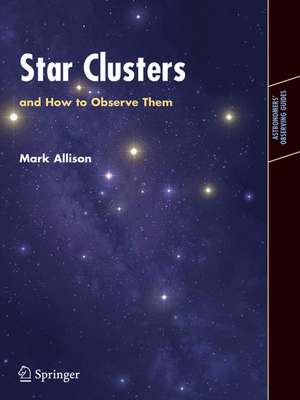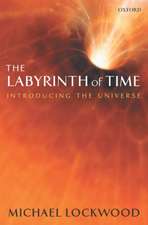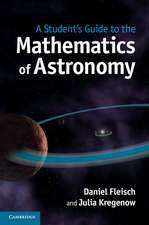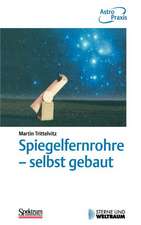Star Clusters and How to Observe Them: Astronomers' Observing Guides
Autor Mark Allisonen Limba Engleză Paperback – 21 dec 2005
Modern commercially-made telescopes enable amateur astronomers to see a surprising amount of detail, and to record – using CCD cameras, video, webcams or even film – some remarkably beautiful and detailed images. Contained here also is detailed information on using refractors, reflectors, and, of course, Meade and Celestron’s ubiquitous range of computer-controlled SCT telescopes.
Din seria Astronomers' Observing Guides
-
 Preț: 183.23 lei
Preț: 183.23 lei -
 Preț: 196.41 lei
Preț: 196.41 lei -
 Preț: 189.37 lei
Preț: 189.37 lei -
 Preț: 193.12 lei
Preț: 193.12 lei -
 Preț: 184.28 lei
Preț: 184.28 lei -
 Preț: 329.89 lei
Preț: 329.89 lei -
 Preț: 273.58 lei
Preț: 273.58 lei -
 Preț: 275.79 lei
Preț: 275.79 lei -
 Preț: 280.19 lei
Preț: 280.19 lei -
 Preț: 254.46 lei
Preț: 254.46 lei -
 Preț: 251.37 lei
Preț: 251.37 lei -
 Preț: 285.68 lei
Preț: 285.68 lei -
 Preț: 254.90 lei
Preț: 254.90 lei -
 Preț: 298.02 lei
Preț: 298.02 lei -
 Preț: 217.51 lei
Preț: 217.51 lei -
 Preț: 300.38 lei
Preț: 300.38 lei -
 Preț: 270.71 lei
Preț: 270.71 lei -
 Preț: 345.09 lei
Preț: 345.09 lei -
 Preț: 342.13 lei
Preț: 342.13 lei -
 Preț: 246.30 lei
Preț: 246.30 lei -
 Preț: 256.78 lei
Preț: 256.78 lei -
 Preț: 210.90 lei
Preț: 210.90 lei
Preț: 213.79 lei
Nou
Puncte Express: 321
Preț estimativ în valută:
40.91€ • 44.43$ • 34.37£
40.91€ • 44.43$ • 34.37£
Carte disponibilă
Livrare economică 01-15 aprilie
Preluare comenzi: 021 569.72.76
Specificații
ISBN-13: 9781846281907
ISBN-10: 1846281903
Pagini: 224
Ilustrații: XII, 212 p. 110 illus.
Dimensiuni: 178 x 254 x 11 mm
Greutate: 0.45 kg
Ediția:2006
Editura: SPRINGER LONDON
Colecția Springer
Seria Astronomers' Observing Guides
Locul publicării:London, United Kingdom
ISBN-10: 1846281903
Pagini: 224
Ilustrații: XII, 212 p. 110 illus.
Dimensiuni: 178 x 254 x 11 mm
Greutate: 0.45 kg
Ediția:2006
Editura: SPRINGER LONDON
Colecția Springer
Seria Astronomers' Observing Guides
Locul publicării:London, United Kingdom
Public țintă
Popular/generalCuprins
Star Cluster Science.- Stars: The Ingredients of Star Clusters.- The Milky Way: Home to Star Clusters.- Open Clusters.- Globular Clusters.- Stellar Associations.- Asterisms.- Extragalactic Clusters.- Cluster Remnants.- Misfits and “Nonexistent” Clusters.- Observing Star Clusters.- Instruments.- Equipment and Accessories.- Observation Planning and Resources.- Observing Guide and Techniques.- Imaging and Recording Objects.- Comprehensive Observing List.- Catalogues and Cluster Data.- Postscript.
Recenzii
From the reviews:
[The] writing style is lucid and eminently friendly, and conveys a virtually contagious enthusiasm for the subject. If, after browsing through this book, you haven't felt the urge to sweep the skies for some of the magnificent star clusters detailed in the text, then you aren't at all interested in viewing the skies. I thoroughly recommend this book.
--Peter Grego, in Popular Astronomy, April-June 2006
"Mark Allison is clearly an enthusiast and keen amateur observer of the Deep Sky, and in Star clusters and how to observe them … . His style is friendly and welcoming to the newcomer to the field. … The observing aspect of the book is more successful than the astrophysical which has many interesting things to say … . for the newcomer to star clusters looking for a relatively inexpensive alternative, it may serve." (Nick Hewitt, Journal of the British Astronomical Association, Vol. 116 (4), 2006)
[The] writing style is lucid and eminently friendly, and conveys a virtually contagious enthusiasm for the subject. If, after browsing through this book, you haven't felt the urge to sweep the skies for some of the magnificent star clusters detailed in the text, then you aren't at all interested in viewing the skies. I thoroughly recommend this book.
--Peter Grego, in Popular Astronomy, April-June 2006
"Mark Allison is clearly an enthusiast and keen amateur observer of the Deep Sky, and in Star clusters and how to observe them … . His style is friendly and welcoming to the newcomer to the field. … The observing aspect of the book is more successful than the astrophysical which has many interesting things to say … . for the newcomer to star clusters looking for a relatively inexpensive alternative, it may serve." (Nick Hewitt, Journal of the British Astronomical Association, Vol. 116 (4), 2006)
Textul de pe ultima copertă
Star clusters are among the most spectacular objects for amateur astronomers to observe and image. They represent the beginning, the present and the future of the universe, from sparse open clusters containing only a dozen stars, to giant globular clusters, each replete with a million suns.
Part one of this detailed book provides a comprehensive review of star clusters – including open, globular, extragalactic, and even cluster remnants – along with their evolution and physics.
Part two is about observing. The larger clusters can be observed through the most basic equipment – normal binoculars or budget telescopes – but Mark Allison talks about instrumentation and accessories, for observers from beginner to expert. Finally there is an observing guide and a comprehensive observing list for a wide range of telescope apertures.
This one book provides all you need to observe star clusters, and to understand the many and varied objects that fall under this classification.
Part one of this detailed book provides a comprehensive review of star clusters – including open, globular, extragalactic, and even cluster remnants – along with their evolution and physics.
Part two is about observing. The larger clusters can be observed through the most basic equipment – normal binoculars or budget telescopes – but Mark Allison talks about instrumentation and accessories, for observers from beginner to expert. Finally there is an observing guide and a comprehensive observing list for a wide range of telescope apertures.
This one book provides all you need to observe star clusters, and to understand the many and varied objects that fall under this classification.
Caracteristici
Provides and in-depth review of star clusters, what they are, how they formed, and what we know about them Spectacular illustrations Gives detailed guidance on what equipment to use to observe star clusters, and how to use it Features an Observing List of suitable clusters to observe according to the instruments available – from binoculars to large-aperture telescopes Includes supplementary material: sn.pub/extras Request lecturer material: sn.pub/lecturer-material














